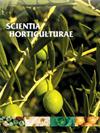康乃馨(Dianthus caryophyllus L.)中褪黑激素生物合成途径基因的全基因组特征及其对外源褪黑激素响应的表达分析
IF 3.9
2区 农林科学
Q1 HORTICULTURE
引用次数: 0
摘要
康乃馨(Dianthus caryophyllus L.)是一种著名的花卉作物,因其色彩多样而备受青睐,在全球范围内具有重要的经济和观赏价值。然而,由于全球对康乃馨花朵的需求,花朵产量成为依赖于作物侧枝数量的一个重要属性。褪黑激素是一种多调节植物激素,在植物生长和发育过程中发挥着重要作用。它由色氨酸通过四种关键酶合成。色氨酸脱羧酶(TDC)、色胺 5-羟化酶(T5H)、羟色胺 N-乙酰转移酶(SNAT)和 N-乙酰羟色胺 O-甲基转移酶(ASMT)。尽管褪黑激素的重要性已得到认可,但其对康乃馨生长发育的影响仍未得到充分研究。在本研究中,我们研究了不同浓度的外源褪黑激素对康乃馨生长模式的影响,随后对褪黑激素生物合成途径基因进行了全基因组特征描述、内部分析和表达谱分析。结果表明,随着褪黑激素浓度的增加,康乃馨的分枝增加,高度降低。体内分析确定了褪黑激素生物合成途径中的十个基因,包括两个 TDC、两个 T5H、一个 SNAT 和五个 ASMT 成员。结构域分析证实了一些特征结构域的存在,如依赖吡哆醛的脱羧酶、细胞色素 P450、乙酰转移酶_1 和 O-甲基转移酶。此外,还分析了理化性质、基因结构、保守基调、启动子区域、基因本体、同源关系和系统进化关系。亚细胞定位预测显示,褪黑激素生物合成酶分布于细胞的各个区室。这些基因在不同外源褪黑激素浓度(100、200、300、400、500 和 1000 µM)下的表达分析表明,在 100 µM 和 500 µM 浓度下,这些基因的表达显著上调,而在 1000 µM 浓度下则没有变化。这些发现表明,由于内源褪黑激素水平的提高,最佳外源褪黑激素浓度会增强生物合成途径基因的表达,最终导致康乃馨分枝的增加。这项研究为今后对褪黑激素生物合成途径基因进行功能表征奠定了基础,以阐明它们在康乃馨生长发育中的作用。本文章由计算机程序翻译,如有差异,请以英文原文为准。
Genome-wide characterization of melatonin biosynthetic pathway genes in carnation (Dianthus caryophyllus L.) and their expression analysis in response to exogenous melatonin
Carnation (Dianthus caryophyllus L.) is a prominent floricultural crop valued for its diverse colors, offering significant economic and ornamental value globally. However, the global demand for its flowers makes flower yield an important attribute that relies on the quantity of lateral branches in the crop. Melatonin as a multi-regulatory phytohormone play vital functions in governing plant growth and development. It is synthesized from tryptophan via four key enzymes. Tryptophan decarboxylase (TDC), Tryptamine 5-hydroxylase (T5H), Serotonin N -acetyltransferase (SNAT), and N -Acetylserotonin O- methyltransferase (ASMT). Although the significance of melatonin is recognized, its impact on the growth and development of carnation remains understudied. In the current study, we investigated the effect of exogenous melatonin at different concentrations, on growth pattern of carnation, followed by genome-wide characterization, in-silico analysis and expression profiling of melatonin biosynthetic pathway genes. Results showed increased branching and reduced height with increased melatonin concentrations up to a point. In-silico analysis identified ten genes in the melatonin biosynthetic pathway, including two TDC , two T5H, one SNAT , and five ASMT members. Domain analysis confirmed the presence of characteristic domains such as pyridoxal-dependent decarboxylase, cytochrome P450, Acetyltransferase_1, and O-methyltransferase. Physiochemical properties, gene structure, conserved motifs, promoter regions, gene ontology, synteny, and evolutionary relationships through phylogeny were also analysed. Sub-cellular localization predictions showed distribution of melatonin biosynthetic enzymes across various cellular compartments. Expression analysis of these genes under different exogenous melatonin concentrations (100, 200, 300, 400, 500, and 1000 µM) revealed significant upregulation at 100 µM and 500 µM, while no change was observed at 1000 µM. These findings suggest that optimal exogenous melatonin concentrations enhance the expression of biosynthetic pathway genes ultimately led to increased branching in carnation due to increased endogenous melatonin levels. This study establishes a basis for future functional characterization of melatonin biosynthetic pathway genes to elucidate their roles in carnation growth and development.
求助全文
通过发布文献求助,成功后即可免费获取论文全文。
去求助
来源期刊

Scientia Horticulturae
农林科学-园艺
CiteScore
8.60
自引率
4.70%
发文量
796
审稿时长
47 days
期刊介绍:
Scientia Horticulturae is an international journal publishing research related to horticultural crops. Articles in the journal deal with open or protected production of vegetables, fruits, edible fungi and ornamentals under temperate, subtropical and tropical conditions. Papers in related areas (biochemistry, micropropagation, soil science, plant breeding, plant physiology, phytopathology, etc.) are considered, if they contain information of direct significance to horticulture. Papers on the technical aspects of horticulture (engineering, crop processing, storage, transport etc.) are accepted for publication only if they relate directly to the living product. In the case of plantation crops, those yielding a product that may be used fresh (e.g. tropical vegetables, citrus, bananas, and other fruits) will be considered, while those papers describing the processing of the product (e.g. rubber, tobacco, and quinine) will not. The scope of the journal includes all horticultural crops but does not include speciality crops such as, medicinal crops or forestry crops, such as bamboo. Basic molecular studies without any direct application in horticulture will not be considered for this journal.
 求助内容:
求助内容: 应助结果提醒方式:
应助结果提醒方式:


